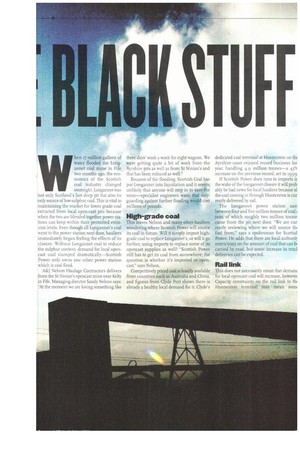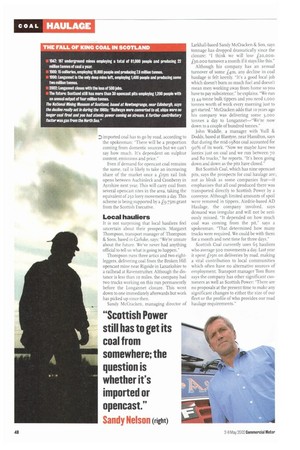YS F 0 1111 I
Page 46

Page 47

Page 48

If you've noticed an error in this article please click here to report it so we can fix it.
The future looked bleak for coal hauliers when Scotland's last deep mine closed in March.
Now the dust has settled, what are their chances of finding alternative work? Guy
Sheppard reports.
hen 17 million gallons of water flooded the Longannet coal mine in Fife two months ago, the economics of the Scottish coal industry changed overnight. Longannet was not only Scotland's last deep pit but also its only source oflow.sulphur coal. This is vital to maintaining the market for lower grade coal extracted from local open-cast pits because when the two are blended together power stations can keep within their permitted emission levels. Even though all Longannet's coal went to the power station next door. hauliers immediately began feeling the effects of its closure. Without Longannet coal to reduce the sulphur content, demand for local opencast coal slumped dramatically—Scottish Power only owns one other power station which is coal fired.
AN Nelson Haulage Contractors delivers from the St Ninian's opencast mine near Kelty in Fife. Managing director Sandy Nelson says: "At the moment we are losing something like three days' work a week for eight wagons. We were getting quite a bit of work from the Ayrshire pits as well as from St Ninian's and that has been reduced as well."
Because of the flooding. Scottish Coal has put Longannet into liquidation and it seems unlikely that anyone will step in to save the mine—specialist engineers warn that safeguarding against further flooding woal cost millions of pounds.
High-grade coal
This leaves Nelson and many other hauliers wondering where Scottish Power will source its coal in future. Will it simply import highgrade coal to replace Longa/I/let's, or will it go further, using imports to replace some of its opencast supplies as well? "Scottish Power still has to get its coal from somewhere: the question is whether it's imported or opencast," says Nelson.
Competitively priced coal is readily available from countries such as Australia and China, and figures from Clyde Port shows there is already a healthy local demand for it. Clyde's dedicated coal terminal at Hun terston on th( Ayrshire coast enjoyed record business las year, handling 4.9 million tonnes—a 459.1 increase on the previous record, set in 1999 If Scottish Power does turn to imports ir the wake of the Longannet closure it will prob ably be bad news for local hauliers because al the coal corning in through Hunterston is cur rently delivered by rail.
The Longannet power station use between four and five million tonnes of coal.; year, of which roughly two million tonne: came from the pit next door. "We are cur rently reviewing where we will source thi fuel from," says a spokesman for Scottisl Power. 1.1e adds that there are local authorit: restrictions on the amount of coal that can bi carried by road, but some increase in trucl deliveries can be expected.
Rail link
This does not necessarily mean that demam for local opencast coal will increase, howevei Capacity constraints on the rail link to thi Hunterston terminal may mean somi 0 imported coal has to go by road, according to the spokesman: "There will be a proportion coming from domestic sources but we can't say how much. It's dependent on sulphur content, emissions and price."
Even if demand for opencast coal remains the same. rail is likely to take an increasing share of the market once a ir5m rail link opens between Auchinleck and Cronberry in Ayrshire next year. This will carry coal from several opencast sites in the area. taking the equivalent of 250 lorry movements a day. This scheme is being supported by a f9.75m grant from the Scottish Executive.
Local hauliers
It is not surprising that local hauliers feel uncertain about their prospects. Margaret Thompson. transport manager of Thompson & Sons. based in Carl uke, says: "We're unsure about the future. We've never had anything official to tell us what is going to happen."
Thompson runs three artics and two eightleggers, delivering coal from the Broken Hill opencast mine near Rigside in Lanarkshire to a railhead at Ravenstruther. Although the distance is less than io miles. the company had two trucks working on this run permanently before the Longannet closure. This went down to one immediately afterwards but work has picked up since then.
Sandy McCracken. managing director of Larkhall-based Sandy McCracken & Son, says tonnage has dropped dramatically since the closure: "I think we will lose f2,o,oclo/3o,o0o turnover a month if it stays like this,"
Although his company has an annual turnover of some 14m, any decline in coal haulage is felt keenly. "It's a good local job which doesn't burn so much fuel and doesn't mean men working away from home so you have to pay subsistence," he explains. "We run 33 44-tonne bulk tippers and you need r,000 tonnes worth of work every morning just to get started." McCracken adds that to years ago his company was delivering some 3,000 tonnes a day to Longannet—"We're now down to a couple of hundred tonnes."
John Waddle, a manager with Yuill Dodds, based at Blantyre, near Hamilton, says that during the mid-198os coal accounted for 90% of its work. "Now we maybe have two lorries just on coal and we run between 70 and go trucks," he reports. "It's been going down and down as the pits have closed."
But Scottish Coal, which has nine opencast pits, says the prospects for coal haulage are not as bleak as some companies fear—it emphasises that all coal produced there was transported directly to Scottish Power by a conveyor. Although limited amounts of spoil were removed in tippers, Airdrie-based AD Haulage, the company involved, says demand was irregular and will not be seriously missed. "It depended on how much coal was coming from the pit," says a spokesman. "That determined how many trucks were required. We could be with them for a month and next time for three days."
Scottish Coal currently uses 65 hauliers who average 500 movements a day. Last year it spent /r5m on deliveries by road, making a vital contribution to local communities which often have no alternative sources of employment. Transport manager Torn Burn says the company has other significant customers as well as Scottish Power: "There are no proposals at the present time to make any significant changes to either the size of our fleet or the profile of who provides our road haulage requirements."
































































































































































